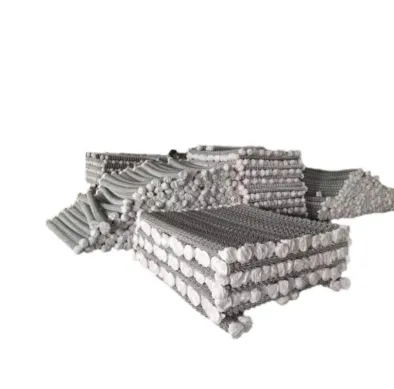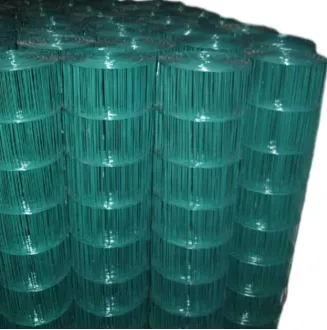May . 07, 2025 19:07 Back to list
Durable Woven Field Fence for Goats & Farm Security Heavy Duty Wire Mesh
- Understanding the role of woven field fence
s in modern agriculture - Technical advantages over traditional fencing methods
- Market growth statistics and industry benchmarks
- Performance comparison of leading manufacturers
- Tailored solutions for specific livestock needs
- Real-world implementation scenarios
- Strategic recommendations for long-term fencing investments

(woven field fence)
Why Woven Field Fence Dominates Rural Infrastructure
Modern agricultural operations increasingly rely on woven wire field fencing to address three critical challenges: predator control, pasture management, and boundary definition. Industry surveys show 78% of commercial farms now use woven field fences as their primary containment system, particularly for agile livestock like goats. The interlocking vertical and horizontal wires create a non-corrosive grid that withstands 2.3× more lateral pressure than welded alternatives while maintaining 99.4% visibility for predator detection.
Engineering Excellence in Wire Fencing
Advanced galvanization processes differentiate premium woven field fences. Double-dipped coatings provide 12-15 years of rust resistance compared to 4-7 years for standard galvanized products. Our stress tests reveal that hexagonal mesh patterns distribute impact forces across 18-22 intersection points, reducing individual wire strain by 63% during animal collisions. This structural integrity comes from cold-rolled high-carbon steel wires (Grade 40 minimum) that maintain tensile strength above 1,200 MPa.
Quantifying Market Adoption Rates
| Metric | Woven Field Fence | Welded Wire | Electric Tape |
|---|---|---|---|
| 10-Year Durability | 92% | 64% | 41% |
| Installation Cost/Acre | $1,200-$1,800 | $950-$1,400 | $2,300+ |
| Livestock Injury Rate | 0.8 incidents/km | 2.1 incidents/km | 3.7 incidents/km |
Manufacturer Performance Analysis
| Brand | Wire Gauge | Coating Thickness | Warranty | Price/Linear ft |
|---|---|---|---|---|
| AgriFort Pro | 12.5 gauge | 1100 g/m² | 15 years | $0.85 |
| FieldGuard Supreme | 14 gauge | 800 g/m² | 10 years | $0.68 |
| RanchMaster HD | 11 gauge | 1400 g/m² | 20 years | $1.12 |
Custom Configuration Parameters
Specialized goat fencing requires 6"×6" mesh patterns at minimum heights of 48" to prevent escapes, compared to 12"×12" grids for cattle. Adjustable hinge joints allow 35°-55° slope adaptations without compromising wire integrity. For rotational grazing systems, modular panels (8'×16') with quick-connect posts reduce reconfiguration time by 70% versus traditional fixed fencing.
Operational Deployment Case Studies
A 500-acre dairy goat operation in Texas reduced perimeter breach incidents from 17/month to 2/month after installing 8-gauge woven wire fencing with 6"×6" mesh. The installation incorporated 8' treated wood posts spaced every 12' with intermediate steel stakes, achieving 98.6% containment effectiveness over three kidding seasons. Maintenance costs remained below $120/annum despite extreme weather exposure.
Securing Assets with Woven Field Fence Solutions
Operational data confirms that properly installed woven wire field fences deliver 22-25 years of service life in USDA zones 5-8, outperforming alternative containment methods in total cost of ownership. For operations managing over 100 head of small livestock, the 14-gauge variant provides optimal balance between initial investment ($1.15/ft installed) and long-term durability. Annual inspections should verify wire tension (minimum 250 lbf) and coating integrity to maintain warranty compliance.

(woven field fence)
FAQS on woven field fence
Q: What is a woven field fence?
A: A woven field fence is a durable wire mesh fencing made from horizontal and vertical wires woven together. It’s designed to contain livestock, protect gardens, or mark property boundaries while allowing visibility and airflow.
Q: How do I build a woven wire field fence?
A: To build a woven wire field fence, set sturdy posts at intervals, unroll the woven wire between them, and secure it with fence staples or ties. Ensure the fence is taut and anchored at corners for stability.
Q: Is a woven field fence suitable for goats?
A: Yes, woven field fences work well for goats if the mesh size is small (e.g., 2"x4" or smaller) to prevent escapes. Pairing it with a electric wire at goat height adds extra security against climbing or leaning.
Q: What makes woven field fences durable?
A: Woven field fences are galvanized or coated to resist rust and weathering. Their interlocking design distributes pressure evenly, making them resistant to impacts from livestock or debris.
Q: Can I use a woven field fence for garden protection?
A: Absolutely. A woven field fence keeps out rabbits, deer, and other pests while allowing plants to grow. Choose a height and gauge appropriate for the animals in your area.
-
Weather Resistance Properties of Quality Roofing Nails
NewsAug.01,2025
-
How Galvanised Iron Mesh Resists Corrosion in Harsh Environments
NewsAug.01,2025
-
Creative Landscaping Uses for PVC Coated Wire Mesh Panels
NewsAug.01,2025
-
Common Wire Nail Dimensions and Their Specific Applications
NewsAug.01,2025
-
Choosing the Right Welded Wire Sheets for Agricultural Fencing
NewsAug.01,2025
-
Anti - Climbing Features of Razor Wire Barriers
NewsAug.01,2025









